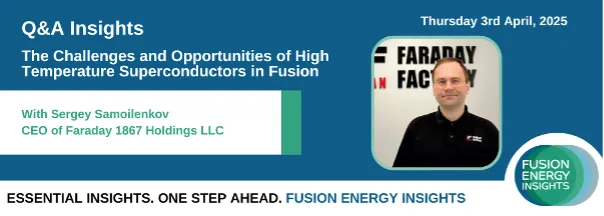3 Key Insights - The Challenges and Opportunities of High Temperature Superconductors in Fusion
By Naomi Scott-Mearns, Membership Project Manager, Fusion Energy Insights
In our member Q&A session on the 3rd April 2025, we discussed high temperature superconductors in fusion, covering the challenges and opportunities with our expert speaker Sergey Samoilenkov, CEO of Faraday 1867 Holdings LLC.

The discussion centred on the application of high-temperature superconductors (HTS) in fusion energy. There is a need for significant investment to meet future demand for HTS in fusion, as the fusion industry consumes over 70% of current HTS production.
Here are three key insights from the event.
1. To keep fusion development on track, fusion companies will need about 200 million metres of HTS tape by the 2030s.
The fusion industry is the current number one market driver of HTS tape. And fusion’s demand for HTS tape is only set to increase: a First Of A Kind (FOAK) fusion power plant will need somewhere between 20 million and a 100 million metres of HTS tape. Fusion companies will need about 200 million metres of HTS tape by the 2030s, which is about a ten times capacity increase in the next 3-4 years.
Sergey believes a production capacity increase for HTS tape on the scale that fusion requires is possible, but it needs quick action and detailed planning. An HTS factory has a 2-3 year lead time.
There are lots of companies globally that produce HTS tape, but only a few – about 2 or 3 – can produce tape at the right volume, requirements and price point for fusion, argues Sergey. Finance can be difficult to secure to enable HTS companies to scale-up production, especially because investors often want to see fusion projects ‘work’ before investing in the supply chain.
2. The current market driver for HTS is fusion, but there are potential future threats to the demand and supply of HTS tape.
A copper shortage is forecast globally from 2027: the copper that’s missing by 2030 is forecast to be equivalent to $70 billion. Copper is essential in electricity grids and the shortage is forecast to stem from electrical grid work. But HTS tapes could be used in electricity grids instead of copper, especially because HTS is cheaper. Sergey says: “currently, wholesale price for a copper cable for 500 ampere is about $200 per kilometre. That was the price of HTS five years ago, now it’s below $100 per kilometre.” This presents a huge opportunity for HTS and Sergey refers to the copper shortage as a “game changer” for HTS.
However, if HTS tape became a viable supply for electrical grids then supply would be diverted away from fusion and this could threaten the future development of fusion, just as FOAK plants are due to be operational. Sergey sees this “as a large threat” to the security of supply of HTS to fusion.
3. Countries that want to secure their fusion industry (and not face delays due to HTS supply bottlenecks) could invest in an HTS factory.
Sergey says that fusion companies need to factor in the investment required for a dedicated facility for HTS tape. If they forecast how much tape they think they will consume and the price point they want to pay then “usually the investment for a factory is pretty much close to the annual revenue of this factory… Suppose Company A wants to buy HTS for $50 million, so let them pay $50 million upfront and wait for two or three years, so the factory is being built and then buy for $50 million in seven years the product from this factory” says Sergey.
Government could subsidise construction of HTS factories and provide minimum guarantees for orders, which helps HTS manufacturers invest in factories and also provides fusion companies with security of supply. As Sergey argues, for an HTS factory “the certainty of orders” is crucial “because nobody would be building capacity and just sitting on this and losing a lot of cash.” Manufacturers need to know that the production capacity will be met with demand.
And finally…
Sergey finished the session by saying: “I think the world will face a scarcity of resources. While the copper shortage underlines some real basis that resources are getting less available. Those actors who will learn how to do more, or the same thing, with less atoms, let's say less stuff, less material, they would be winning ultimately. People just want to have more comfort, more energy, more everything, and we need to learn how to do this with less atoms.”
